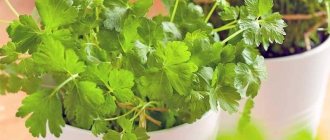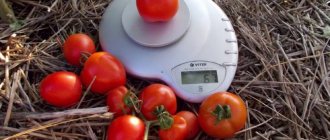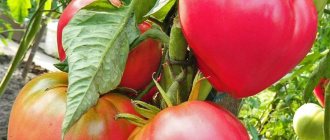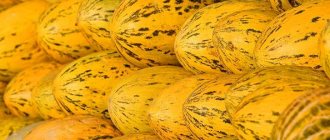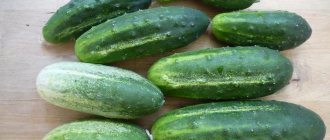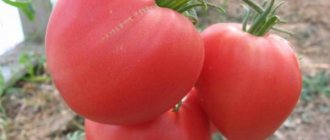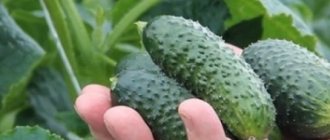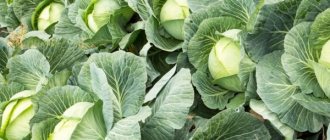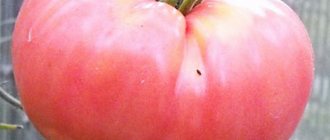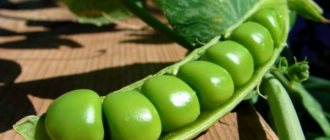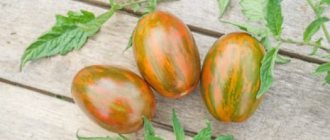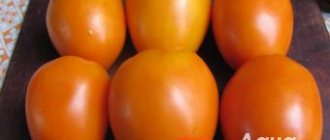Once upon a time, almost all known tomatoes were red. Then yellow, pink, even emerald appeared. Nowadays you won’t surprise anyone with orange fruits; many gourmets find them especially tasty. Whether this is true or not is a debatable question, but the Chukhloma variety is really very popular. Its fruits not only decorate a salad when cut together with tomatoes of a different color, but also turn out to be very tasty when eaten on their own.
- 2 Appearance
- 3 Advantages and disadvantages, features, differences from other varieties
- 4 Features of planting and growing Chukhloma tomato
- 5 Reviews
5.1 Video: a gardener’s opinion about the Chukhloma variety
Description of the variety
The Chukhloma tomato was bred in 2004 and is an indeterminate plant.
The variety is mid-season: 110–115 days pass from sowing to the appearance of the first fruits. The height of the main stem is 2 m or more. The first flowers are formed above the 9th leaf, the rest - every 3 leaves. Each cluster bears up to 15 fruits.
Distinctive features
The peculiarity of the Chukhloma variety is its appearance. Large bushes, hung with garlands of pepper-shaped tomatoes of varying degrees of ripening: from light green to bright orange. The taste of ripe fruits is sweet and delicate.
Fruit characteristics and yield
Oval elongated tomatoes have a bright orange color without darkening at the stalk. The skin is durable with a slight waxy coating. Vegetables do not crack during transportation. They retain their marketable appearance and taste for a month, so the variety is often grown for sale.
If the rules of agricultural technology are followed, up to 6 kg of crop can be harvested from one bush. Fruit weight - 150 g. Chukhloma tolerates unfavorable climatic conditions, but in regions with a cool climate it is grown in greenhouses or under film cover.
Tomato diseases
It is believed that the Chukhloma variety is resistant to many nightshade diseases. But to protect tomatoes from late blight, it is better to use preventive measures.
This fungal disease usually appears from the middle of the season, when heavy rains begin. The disease spreads in high humidity and low temperatures. The entire plant and even the fruits are affected. The disease appears in the form of grayish-brown spots.
As a preventive measure it is recommended:
- Avoid planting Chukhloma tomatoes next to potatoes or after potatoes and peppers;
- Regularly pruning the plant and weeding the ground;
- if the Chukhloma tomato is grown in a greenhouse, it is necessary to ventilate it frequently and prevent condensation from forming on the walls;
- the remains of the tops are burned, and the greenhouse is treated with bleach.
The Chukhloma tomato responds gratefully to timely feeding and constant care. Therefore, with due attention, even a novice gardener will reap a decent harvest.
How to grow seedlings
The variety bears fruit both in open and closed ground, but the crop produces maximum yield in greenhouse conditions.
Seedlings are grown for 45–50 days, and not 2 months, like other varieties:
- On March 15, the seeds are disinfected and germinated;
- On March 20, sowing is carried out;
- On March 25, shoots appear;
- On May 10, the plants dive to a permanent place.
On a note! With this scheme, the first fruits will ripen at the end of July.
Seed preparation
Chukhloma is a variety, not a hybrid, so some gardeners collect seeds from their own harvest. In this case, the grains must be disinfected.
The planting material is pickled for 20–30 minutes in a 1% solution of potassium permanganate. Then they are washed under running water and sprouted in damp cotton cloth until sprouts appear. The fabric is periodically moistened, but not over-moistened: this will lead to rotting of the seeds. The procedure takes 3-4 days.
For your information ! Purchased branded seeds are disinfected by the manufacturer, so they are only germinated.
Container and soil
Seedlings are grown in the following containers:
- peat tablets or cups;
- containers with cells and a lid;
- wooden boxes;
- disposable cups;
- cut plastic bottles or milk and juice boxes.
When the seeds hatch, soil preparation begins. To do this, mix 2 parts peat and 1 part sand. To 10 liters of the resulting substrate add 1 liter of wood ash.
Sowing
For more convenient cultivation of crops, peat tablets are used. They are placed in a plastic container and moistened. When they increase in volume, seeds are planted and the container is wrapped in film to create greenhouse conditions. The container is ventilated once a day. When the roots emerge from the cylinder, the tomatoes are dived into separate containers.
The sowing itself is carried out at a distance of 2 cm from each other and 3 cm between the rows. Planting depth - 1 cm.
Growing and care
Care includes three main procedures:
- soil moisture;
- turning plants towards the light so that the shoots do not bend;
- application of fertilizers.
Picking tomatoes is done in large containers, while the stems are deepened to the cotyledon leaves. During the seedling period this is done 1-2 times.
Tomatoes are fed:
- "Agricola";
- "Athlete"
- nitroammophoska.
Some vegetable growers use folk remedies as fertilizers:
- Ash extraction . Add 80 g of wood ash to 5 liters of water. The mixture is infused for a day and then filtered. Moisten the soil with the solution and spray the leaves.
- Yeast. To prepare the nutrient mixture, a yeast briquette (10 g) is stirred in 10 liters of water. After infusion for a day, the seedlings are watered with the solution. The product is not stored, but used immediately.
Growing rules
To get the harvest 10 days earlier, and the plant to grow healthy and hardened, you need to grow the seedlings correctly. In order to get a high yield, you should prepare the soil and follow the seed germination technology.
Planting seedlings
To plant seeds for seedlings, you need to follow simple rules.
- The soil should be light and nutritious. You can buy it at the store or mix it yourself. To do this, take nutrient soil, peat and river sand in equal proportions. Before sowing seeds, the soil is spilled with boiling water or a weak solution of potassium permanganate.
- The seed material is soaked in a growth stimulator for 24 hours. Next, lay it out on a saucer, cover it with damp gauze, and place it in a warm, well-lit place for germination. In order for the seeds to germinate quickly, the gauze should not dry out.
- The boxes are filled with soil, moistened, holes are made, seeds are sown to a depth of 1.5 cm at intervals of 2 cm and sprinkled with soil.
- After planting, cover the container with glass or film and put it in a warm and well-lit place.
- After the first shoots appear, the cover is removed and the ground is moistened with a spray bottle.
- When 3-4 true leaves appear on the plant, pick them in different cups.
- To prevent the plant from stretching, it is moved to the most illuminated place.
- Water the seedlings with settled, warm water, being careful not to expose the young roots.
- 2 weeks before planting in a permanent place, the seedlings must be hardened off. To do this, the containers are taken out into the open air every day, increasing the residence time.
How to grow tomatoes
Plants are planted in a sunny, windless area with moderately moist soil. The soil should be light and turfy, with low acidity. The garden bed has been dug up since the fall. Chukhloma has strong immunity to diseases, however, for prevention, before planting, the soil is treated with a weak solution of potassium permanganate.
Landing
4 plants are planted per 1 m2. Planting pattern - 60x40 or 70x35 cm. A small layer of humus and superphosphate or ash is added to the bottom of the holes.
Since the variety is tall, a support is immediately installed. To do this, use a trellis with a coarse mesh or drive wooden stakes into the ground.
Care
Tomatoes are cared for as follows:
- Since the variety is tall, the plants are tied to a support. This will keep the crop healthy and in shape.
- Every week they get rid of the stepsons, the length of which has reached 5-6 cm. This way, the nutrients will go to the development of fruits, and not green mass.
- To make the bush powerful, leave 1 central stem, and for high productivity the plant is formed into 2 trunks.
- Water tomatoes once a week, but if it’s hot - 2 times;
- The soil is regularly loosened and weeds are removed after watering the plants.
In order for tomatoes to develop well, they are fertilized on time. Nutrients are added at the stages of flowering and fruit formation:
- A few days before flowering, tomatoes are fertilized with mullein solution (4 kg per bucket of water).
- A week after the inflorescences fall off, the plants are fed with superphosphate (400 g per 10 liters of water).
- To improve the taste of vegetables, during the period of fruit formation, the crop is fertilized with a solution of ammonium nitrate (30 g per 10 liters of water). For 1 bush use 5 liters of the mixture.
Regardless of the chosen planting location, mulching is carried out to retain moisture in the soil.
Vegetable growers do not encounter any particular difficulties when growing this variety.
Diseases and pests
The Chukhloma tomato is resistant to diseases and pests, but due to improper care or exposure to external factors, a small risk of disease still exists. To preserve the harvest, the bushes are regularly inspected for diseases and pests.
The most common diseases and pests:
- Fusarium wilt of tomatoes is a fungal pathology. The bushes look as if they do not have enough moisture: the lower leaves turn yellow, and the stem cracks and becomes covered with a black crust. To prevent plants from getting sick, follow the rules of crop rotation. If the culture is already affected, special drugs are used: Trichodermin or Previkur.
- Gray rot. Affects crops in greenhouse conditions. The disease destroys leaves and stems and spreads to the vegetables themselves. Dark spots with a grayish tint are eliminated by ventilating the structure.
- Late blight. First, the leaves dry out and turn yellow, then the fruits suffer. The reason is excess moisture. To prevent plants from getting sick, follow the rules of crop rotation and watering regime. For treatment, Tattu, Kvardis or Mikosan are used.
- Curling of leaves . A fungal disease that affects crops at different stages of development. Control measures include timely feeding with the necessary microelements.
- Whitefly is a white midge that is localized on the underside of leaves. Appears when tomatoes grow in a greenhouse. Eliminate the pest by ventilating buildings and using insecticides.
- Spider mites are small arachnids that spoil crop leaves. If measures are not taken in a timely manner, the vegetation becomes covered with yellow spots and dies. They get rid of the pest using biological products: for example, “Actophyte”.
- Aphids are an insect that destroys vegetables in greenhouses and open ground. They destroy it with folk remedies (dust, ash, herbal decoctions) or insecticides.
To reduce the risk of crop disease, follow the rules of watering and crop rotation, and apply fertilizer correctly.
PHYTOPHORA HAS STARTED!! HOW TO SAVE THE TOMATO HARVEST!!!
Tomato fertilizer
Chukhloma tomatoes respond well to fertilizing. Although excessive use of supplements is harmful. It is better to “underfeed” tomatoes than to over-fertilize them. Therefore, it is advisable to gradually introduce fertilizing.
Advice! During the season, it is recommended to feed the tomatoes at least three times. Moreover, you can use both inorganic fertilizers and organic matter.
The first feeding is carried out a week and a half after transplantation. The best option is to use special water-soluble mineral mixtures. Fertilizer is applied to the soil during watering and it is advisable to mulch the soil afterwards.
As soon as fruits set on the second cluster, fertilizer is applied again. Use a solution: add a tablespoon of mineral fertilizer to 10 liters of organic infusion. Two liters of solution are poured under the Chukhloma bush.
As soon as the first ripe fruits appear, it is necessary to apply fertilizer a third time. You can also use an organic+inorganic composition. Moreover, 2-2.5 liters of solution are poured under each bush.
Advice! If Chukhloma tomatoes gain green mass and bloom modestly, it is necessary to abandon the share of nitrogen in the mixtures and increase the dose of phosphorus fertilizers.
There is no specific composition of fertilizers. Each gardener uses his own set of fertilizers. But it is imperative to take into account the structure of the soil, its composition, and the condition of the tomatoes.
Advantages and disadvantages of the variety
The main advantages of Chukhloma:
- high productivity;
- excellent taste and aroma of vegetables;
- long fruiting;
- strong immunity to diseases;
- versatility in application;
- good transportability;
- long-term storage;
- the ability to collect seeds from your own harvest.
There are also disadvantages:
- the plant needs to be tied to a support;
- the culture needs to be stepsoned;
- The fruits have weak juiciness.
Landing
Suitable time for planting seeds for seedlings: March - early April (in a greenhouse - in May).
A tomato ripens in an average of 110 days.
This variety is recommended to be grown in greenhouse conditions.
Growing seedlings
It is recommended to remove all side shoots at the initial stage, leaving only one (the strongest) stem. When the first true leaves appear, you need to pick immediately. The bush should form into one stem, which will allow the fruit clusters to develop evenly and grow upward.
Sowing seeds in incubators must be done 40 days before the main planting date. Seedlings can be placed in containers or individual boxes to produce sprouts. “Balcony lighting” will not be enough for both the growth of seedlings and the growing of fruits, so it is better to abandon this idea: “Chukhloma does not like balconies.”
Watering should be done with warm water so as not to damage organic processes. It is strictly forbidden to “flood” the seedlings - moisture accumulation will damage the roots and begin the process of rotting of the plant. It is recommended to use a commercial gardener's indicator to determine moisture levels. They are inexpensive and will allow you to effectively control the level of irrigation.
Water for watering seedlings should be filtered or well water used. This will minimize the risk of a chemical reaction with chlorine in the soil and will allow you to have healthier seedlings. After this, you can plant the sprouts in the ground.
Landing in the ground
The soil must be prepared in advance; you can use humus or commercial fertilizers for Chukhloma. It is better to plant in places where there were no tomato crops last season. Stones and weeds will interfere with the root system; if possible, they should be removed.
Ready seedlings are planted according to a planting pattern of 45x65 centimeters. It turns out that 4 to 5 plants can be placed per 1 m2 - these are normal indicators. The depth of the planting hole should be 15-20 cm.
Afterwards, you need to water each bush with warm water. If the water is “from underground” (its temperature is lower than necessary), it is recommended to let the water sit for 3-4 hours. Support for the bush is possible, but not required.
Farmer reviews
The Chukhloma tomato is cultivated in almost any climatic conditions, in open and closed ground. The variety has more advantages than disadvantages, which is why vegetable growers prefer it.
Elena, Perm: “Last year I grew the Chukhloma variety. The bushes are tall, up to 2.5 m. The plant has many cluster-like clusters - each with up to 10 tomatoes. The fruits are slightly dry; if they are overripe, voids appear inside. They taste sweet. The vegetables are oblong - I put them in the jar while standing, but they don’t crack. The peel is strong, but not rough. The tomatoes look great in a jar. I liked this type of culture. Next time I will plant more. I advise everyone!".
Olga, Kirov: “Before this, my mother always grew the Chukhloma tomato. That year I tried to plant it too. The variety is quite productive and does not require special attention. The bushes do not get sick and are not affected by pests. Plants formed into 1 stem. Tomatoes have an excellent taste, but I like them better when pickled, and they look wonderful. In addition, the culture does not cause allergies, which is important in our family.”
Vasily, Tyumen: “ In a gardening store, the seller advised me to buy Chukhloma tomato seeds. I immediately liked the photo on the packaging. I grew tomatoes in open ground. I didn't like this variety. One vegetable weighed about 80–100 g. The taste was average, neither sour nor sweet. I will look for new varieties for myself.”
Appearance
Tomatoes of the Chukhloma variety are well recognizable: there are not many varieties that have fruits of cylindrical shape, medium size and orange color. It is sometimes said that the shape of the fruit resembles a banana. This appears to be an inaccurate comparison: some tomatoes may actually bend, but the bulk of the tomatoes remain fairly straight and would be more accurately called pepper tomatoes. There are many fruits on the bushes at the same time, and the plants resemble a New Year tree.
The fruits look quite appetizing, but they can not only be eaten immediately, but also preserved
Fruit
Tomatoes of the Chukhloma variety have a bright orange hue. The weight of one fruit can reach 120 grams. Of course, to achieve this result, you must follow all the rules for growing a plant. It is quite easy to distinguish Chukhloma from other varieties. The fruits are banana-shaped, have a tough skin and fleshy pulp. Thanks to this, they are widely used for whole-fruit canning and for sale, which is confirmed by numerous reviews.
Important: To ensure high yields, it is necessary to take into account that the best predecessors for Chukhloma tomatoes are dill, parsley, zucchini, cauliflower and carrots.
As the description of the variety indicates, Chukhloma tomatoes are distinguished by their high transportability and long-term storage. That is why they are very popular among farmers. The fruits are grown not only for sale, but also for canning. They can also be used for preparing various dishes and for consumption in their pure form.
general characteristics
Chukhloma bushes belong to the indeterminate type. Their height in greenhouses reaches 2 m. The first inflorescence is tied above the 10-11 leaf and then after 3 leaves. The variety is recommended for garden plots, household plots and small private farms. The cultivation zone includes the European regions of the country. The main growing method is greenhouse and under film covers.
The variety is mid-season, the time from germination to the first ripe tomatoes is 111-118 days. But this greatly depends on the climate and weather.
The indeterminate nature of the plant determines the extended fruiting period, which is a big plus for a salad variety.
Working with seeds
Chukhloma is a tomato variety, and therefore can be grown from its own seeds. In this case, they must be disinfected.
Etching
Of the different etching methods, preference should be given to processing in a solution of potassium permanganate. Here, the color of the solution already characterizes its concentration and gross errors are excluded. The seeds are treated in a pink solution for 15-20 minutes with occasional stirring, after which they are washed in running water and placed for germination.
Germination
Purchased branded seeds have already undergone pre-sowing treatment and do not require home treatment. To germinate seeds, they are laid out on a piece of cotton cloth soaked in water and placed in an airtight container. This insulation allows you to maintain constant humidity. At the same time, the seeds should not be in water - this can lead to their rotting. In a warm place (26-28 degrees) the procedure will take 3-4 days. It is finished when the length of the white sprouts is equal to the size of the seeds.
